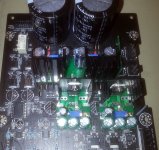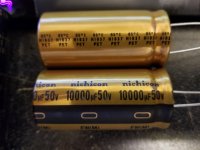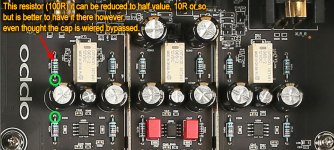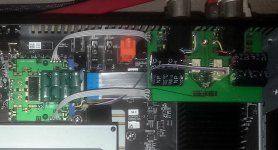I would love to see someone successfully blind test distinguish between a mains fuse and a circuit breaker
This is my solution for the AC/DC coupling selector. It fit for both 205 as 105 models. Here in picture, it is not yet connected to the output caps.
Oppo could very easy (and simple) implement a such selector into the stereo board design, giving the option to the interested user to chose the output type, for his particular configuration.
The Easiest solution is just to solder a wire across the output coupling capacitors. This is what we did on the 105, and there was no significant DC offset.
Why not just do this again for the 205?
E
Yes, of course this is the easiest way. Especially when one do it only once for himself. If one may want to experiment different configurations, or gears connected to an such player, then it could be fine to have a (more convenient) option to change/revert the AC coupling, to an direct. However, my proposed solution it is not a must. A simple wire it solve it as well.
Last edited:
My improvements so far, for the analogue power stage of 205.
Massive primary filtering capacity. Replaced the original rectifier diodes, with Schottky. Replaced the original +/- regulators with LM2991/2941, mounted on a new designed module. Added pre regulators for DAC power rails: one regulator for the digital DAC power rails, and one regulator dedicated to the analogue power rails (AvccL/R). This last pre regulator it use the multi-channel board DAC power, which it became available, as I will not use that board/outputs. In case the multi-channel board should be used, then there is a solution, by keeping this pre regulator in same place.
I kept the original regulators for DAC in place for moment. BTW, the DAC AVCC power is original done by the book (ESS9038Pro datasheet). Oppo used a dedicated ADM7151 for each of the L/R rails, and it succeed the production line performance to have two precise equal voltages for these rails. So, I appreciate there is no reason to replace these very good regulators, but only I improved their filtering capacities in/out.
The main problem for the original analogue power stage is the very high ripple at the low noise regulators inputs, because a wrong dimensioned power source as poor filtering. Now is corrected and improved.
Massive primary filtering capacity. Replaced the original rectifier diodes, with Schottky. Replaced the original +/- regulators with LM2991/2941, mounted on a new designed module. Added pre regulators for DAC power rails: one regulator for the digital DAC power rails, and one regulator dedicated to the analogue power rails (AvccL/R). This last pre regulator it use the multi-channel board DAC power, which it became available, as I will not use that board/outputs. In case the multi-channel board should be used, then there is a solution, by keeping this pre regulator in same place.
I kept the original regulators for DAC in place for moment. BTW, the DAC AVCC power is original done by the book (ESS9038Pro datasheet). Oppo used a dedicated ADM7151 for each of the L/R rails, and it succeed the production line performance to have two precise equal voltages for these rails. So, I appreciate there is no reason to replace these very good regulators, but only I improved their filtering capacities in/out.
The main problem for the original analogue power stage is the very high ripple at the low noise regulators inputs, because a wrong dimensioned power source as poor filtering. Now is corrected and improved.
Attachments
Last edited:
Primary Filtering Capacity?
Hi Coris, I had these caps left over from a project I did not complete, would I be able to use one of the pair of caps in the pictures to upgrade the Primary Filtering on the Analog board, providing I have enough room? Which one would be better if so, and again providing they fit.
My improvements so far, for the analogue power stage of 205.
Massive primary filtering capacity. Replaced the original rectifier diodes, with Schottky. Replaced the original +/- regulators with LM2991/2941, mounted on a new designed module. Added pre regulators for DAC power rails: one regulator for the digital DAC power rails, and one regulator dedicated to the analogue power rails (AvccL/R). This last pre regulator it use the multi-channel board DAC power, which it became available, as I will not use that board/outputs. In case the multi-channel board should be used, then there is a solution, by keeping this pre regulator in same place.
I kept the original regulators for DAC in place for moment. BTW, the DAC AVCC power is original done by the book (ESS9038Pro datasheet). Oppo used a dedicated ADM7151 for each of the L/R rails, and it succeed the production line performance to have two precise equal voltages for these rails. So, I appreciate there is no reason to replace these very good regulators, but only I improved their filtering capacities in/out.
The main problem for the original analogue power stage is the very high ripple at the low noise regulators inputs, because a wrong dimensioned power source as poor filtering. Now is corrected and improved.
Hi Coris, I had these caps left over from a project I did not complete, would I be able to use one of the pair of caps in the pictures to upgrade the Primary Filtering on the Analog board, providing I have enough room? Which one would be better if so, and again providing they fit.
Attachments
Main Fuse VS Circuit Breaker
I would also like to see how the Circuit Breaker is actually mounted to the LPM, I have that particular LPM which I have installed but have not installed the Circuit Breaker which I purchase from Digi Key in place of the existing fuse.
I would love to see someone successfully blind test distinguish between a mains fuse and a circuit breaker
I would also like to see how the Circuit Breaker is actually mounted to the LPM, I have that particular LPM which I have installed but have not installed the Circuit Breaker which I purchase from Digi Key in place of the existing fuse.
Hi Coris, I had these caps left over from a project I did not complete, would I be able to use one of the pair of caps in the pictures to upgrade the Primary Filtering on the Analog board, providing I have enough room? Which one would be better if so, and again providing they fit.
I suspect the caps you have it may be too high to fit into the available place. These caps should be into 40mm high, and max 35mm diameter to fit so as it are original mounted. Else it should be mounted on the board downside.
Also a 10000µ is not a big deal to have in that place, and definitely not necessary 50v rating. As lower the voltage rating, as smaller the dimensions. In that place 25v is perfect. The value should be chosen as high as the dimensions it allow....
However, only replacing these main filtering caps, it may not solve completely the ripple problem, but only for +/- 12v rails. DAC chip power it suffer for the same issue (much too low filtering capacity).
Last edited:
Hi Coris,
As for output stage cap removal, there is normally an associated resistor before the cap which should also be removed.
As for output stage cap removal, there is normally an associated resistor before the cap which should also be removed.
Solution for AC/DC Coupling Selector Kit?
Hi Coris, will you be offering the purchase of the AC/DC coupling selector as a kit?
Mark
This is my solution for the AC/DC coupling selector. It fit for both 205 as 105 models. Here in picture, it is not yet connected to the output caps.
Oppo could very easy (and simple) implement a such selector into the stereo board design, giving the option to the interested user to chose the output type, for his particular configuration.
Hi Coris, will you be offering the purchase of the AC/DC coupling selector as a kit?
Mark
I have available the AC/DC selector for those interested. Please PM me.
Concerning the resistor on the signal path after the AC coupling caps, I recommend to keep it in place, even thought its value it can be reduced.
For those who may want to try (wire) bypassing the AC coupling caps, without removing the caps, or even not dismounting the board, I suggest connecting together the marked points (green circles) on the picture hereby. The same for those who may want using my selector.
For a quality AC coupling, the original caps it should be replaced with non polarised ones, as bypassed with some film 1-2µF caps. If you are sure your preamp/amp it is AC coupled on its inputs (caps or transformer), then wire bypassing is the best choice.
Concerning the resistor on the signal path after the AC coupling caps, I recommend to keep it in place, even thought its value it can be reduced.
For those who may want to try (wire) bypassing the AC coupling caps, without removing the caps, or even not dismounting the board, I suggest connecting together the marked points (green circles) on the picture hereby. The same for those who may want using my selector.
For a quality AC coupling, the original caps it should be replaced with non polarised ones, as bypassed with some film 1-2µF caps. If you are sure your preamp/amp it is AC coupled on its inputs (caps or transformer), then wire bypassing is the best choice.
Attachments
Hi all, I just wanted to share some very interesting papers published by Walter Jung and Richard Marsh on Capacitors and how they effect sound. Walt had modded my old Philips CD-880 and my Adcom GFP 565 Pre-amp back in the late 80's early 90's with stunning results. Unfortunately my CD-880 Laser has seen better days and replacements are expensive. I would still be using the 880 as a CD source.
Now I'm using the UDP-205 and using the Parasound Halo Integrated Amp.
Anyway here are the links to Walters two articles on Picking Capacitors, Enjoy they are a good read.
http://waltjung.org/PDFs/Picking_Capacitors_1.pdf and http://waltjung.org/PDFs/Picking_Capacitors_2.pdf . Walt goes into great detail of how each type of Capacitors in the signal path effect sound quality.
I hope you find this useful and informative, please excuse me if you have are already familiar with this read.
Moto
Now I'm using the UDP-205 and using the Parasound Halo Integrated Amp.
Anyway here are the links to Walters two articles on Picking Capacitors, Enjoy they are a good read.
http://waltjung.org/PDFs/Picking_Capacitors_1.pdf and http://waltjung.org/PDFs/Picking_Capacitors_2.pdf . Walt goes into great detail of how each type of Capacitors in the signal path effect sound quality.
I hope you find this useful and informative, please excuse me if you have are already familiar with this read.
Moto
Last edited:
The headphone output is really excellent (I use it as line out). Much better quality than XLR...
XLR it have something harsh into it. The headphone out is much more natural, and the dynamics are even better.
Hi Coris, Could you tell me where you purchased the cable to go from headphone to RCA?
Thanks
Moto.
Actually there is not about a cable, but about an adapter headphone jack 6,2mm to RCA (female). Actually I haven`t purchased such adapter, but I made it myself (a headphone jack soldered together with two female RCAs). For a more flexible (souple) approach, one can use some short cables in between the connectors.
Well, such improvisation it may be only for testing reasons... Or made it more aesthetically somehow, it can be a good finally solution. I suppose there are many such adapters or even cables out there, adapting a headphone 6,2 mm output, to RCA.
Sorry for not answering as expected...
Well, such improvisation it may be only for testing reasons... Or made it more aesthetically somehow, it can be a good finally solution. I suppose there are many such adapters or even cables out there, adapting a headphone 6,2 mm output, to RCA.
Sorry for not answering as expected...
Last edited:
Now DC coupling option for my stereo XLR outputs on 203. The result is over all expectations. Definitely better than the stock 205, with Sabre Pro inside...🙂
I do not want say that the AKM DAC chip it may be better as performances than a Sabre Pro... Here is about Oppo implementation/design approaches for both 203 and 205 audio sections.
I do not want say that the AKM DAC chip it may be better as performances than a Sabre Pro... Here is about Oppo implementation/design approaches for both 203 and 205 audio sections.
Attachments
Pic not working here.Now DC coupling option for my stereo XLR outputs on 203. The result is over all expectations. Definitely better than the stock 205, with Sabre Pro inside...🙂
I do not want say that the AKM DAC chip it may be better as performances than a Sabre Pro... Here is about Oppo implementation/design approaches for both 203 and 205 audio sections.
Well I'm at a cross road, I have all the parts I need to replace the existing output caps. I have two brands, Panasonics OSCONS SECP 470uf 16v from DigiKey and ELNA RFS Silmic IIs 470uf 16v from Parts Connexion, and the bypass caps Wima 1.0uf 62v polyester. I cannot fully bypass the Eletrolytics due to my Parasound Halo Integrated design, I have already decided that after speaking to the techs at Parasound.
Not sure which I'm gonna go with, I would like to use Polyprops as my bypass caps but i'm not sure what value to use and I know they run big and keeping the leads short is also a consideration. After reading a bit I learned that the best cap to bypass the Electrolytics is a Metalized Polypropylene because of how transparent they are compared to the other material, with Teflon being the most transparent.
I already have replaced my switching power supply of my 205 with a liner type.
Time to do some more research, I'm open to your thoughts and suggestions.
Thanks much in advance 🙂
Mark.
Not sure which I'm gonna go with, I would like to use Polyprops as my bypass caps but i'm not sure what value to use and I know they run big and keeping the leads short is also a consideration. After reading a bit I learned that the best cap to bypass the Electrolytics is a Metalized Polypropylene because of how transparent they are compared to the other material, with Teflon being the most transparent.
I already have replaced my switching power supply of my 205 with a liner type.
Time to do some more research, I'm open to your thoughts and suggestions.
Thanks much in advance 🙂
Mark.
Last edited:
Hi all, I wanted to share this with you all. I found a good cable to go from the headphone jack to RCA's. Found it on Amazon, here is the link.
Amazon.com: Hosa TRS-202 1/4 inch TRS to Dual RCA Insert Cable, 6.6 feet: Musical Instruments
I do agree Coris, out of the three outputs (Stock) the headphone sounds the best, though it does lack a little punch, but the increase in transparency and clarity especially in the upper frequencies is great.
Mark
Amazon.com: Hosa TRS-202 1/4 inch TRS to Dual RCA Insert Cable, 6.6 feet: Musical Instruments
I do agree Coris, out of the three outputs (Stock) the headphone sounds the best, though it does lack a little punch, but the increase in transparency and clarity especially in the upper frequencies is great.
Mark
- Home
- Source & Line
- Digital Source
- Oppo new UDP series players - 203/205 - Discussions, upgrades, modifications





